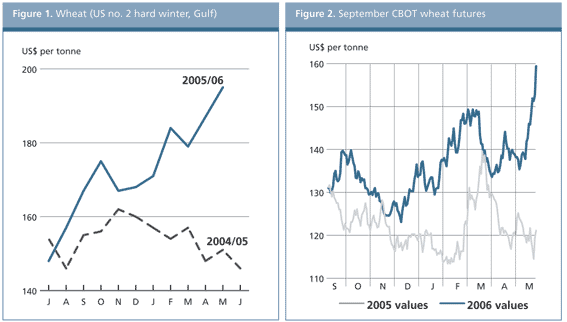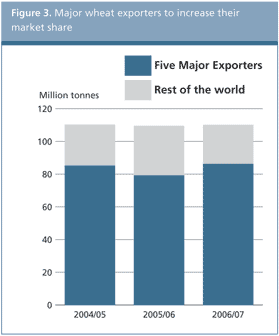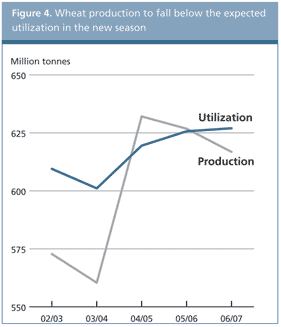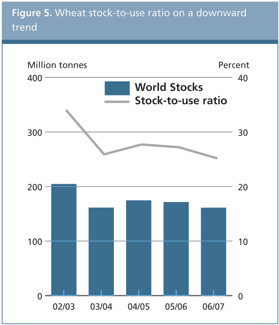No.1† †June†2006†† †June†2006†† | ||
 |
Food Outlook | |
| Global Market Analysis | ||
|
WHEAT
Following a generally stable and flat movement during the 2004/05 season, international wheat prices followed a more volatile path in 2005/06 and started to surge more consistently during the closing months of the season. In May, the United States hard wheat export prices were up over US$50, or 33 percent, from the beginning of the season. Growing concerns over tighter export supplies and robust weekly buying activities pushed up May spot values to the highest levels in almost four years. As the season progressed, soft wheat prices also gained, but the increase remained modest because of remaining large supplies of Black Sea origin wheat. In the EU, in spite of large supplies, wheat sales remained constrained by continuing strength in the euro against the US dollar. In spite of its strong currency, however, the EU has maintained the level of export refunds (subsidies) at a relatively low level in recent weeks, maximum Ä6.20. In mid-May, the United States wheat futures climbed to two-year contract highs. Later in the month, futures for September delivery at the Chicago Board of Trade (CBOT) were quoted above US$150 per tonne, up more than 30 percent from the corresponding period last year. Several factors were behind rising wheat futures in recent weeks, including worries about the winter crop conditions in the United States, prospects for a much tighter world balance in 2006/07, driven by smaller world production and stocks, and also spill over buying by index-type funds following the strong surges in metals and energy markets.
FAO forecasts world wheat output in 2006 at about 617 million tonnes, 1.6 percent down from 2005. This represents the second consecutive decline after the record crop of almost 632 million tonnes in 2004 but still well above the average of the past five years. The bulk of the reduction this year is expected in the United States, the Russian Federation and Ukraine. In the United States, the adverse effect of drought on the winter crop, which normally accounts for about 70 percent of total output, is the main reason behind another production drop forecast this year. However, the early outlook for a smaller spring crop also, because of poor planting conditions (excessive rain and cold temperatures) have contributed to the expectation that this yearís aggregate output (winter and spring) could be the smallest since 1988 and some 8 percent below the average of the past five years.  † Adverse weather is also responsible for unfavourable production prospects in the Russian Federation and Ukraine, where outputs are forecast to fall by about 12 and 40 percent respectively. In the Russian Federation, severe conditions have increased winterkill well above normal, while lack of inputs and/or prohibitive prices make it unlikely that such a large lost area will be replanted with spring wheat. In Ukraine, the area was significantly reduced already from planting time due to adversely dry weather and farmersí lack of sufficient funds for necessary inputs. These decreases, along with several smaller reductions expected in other significant wheat producers such as Canada, India, Pakistan and Romania, would more than offset this yearís increases, led by Argentina, China, North Africa and the EU. The EUís wheat crop is expected to rebound from last yearís below-average harvest reflecting a slightly larger area forecast and expectation of much better yields in parts, most noticeably in southern France, Spain and Portugal after last yearís drought-reduced levels. Similarly, in North Africa, where the harvest is already underway, weather conditions improved greatly this season after last yearís drought, promoting a strong recovery in output. In China, wheat production is forecast to increase slightly from last yearís good level due to higher plantings and yields. In Argentina, where the 2006 crop has yet to be planted, early indications point to a rebound in output, reflecting a sharp increase in area in response to favourable prices and much improved soil moisture. Table 1. World wheat market at a glance
*low-income food-deficit countries
As this marketing season is drawing to a close, trade estimates are becoming firmer. The current estimate for world wheat trade in 2005/06 (July/June) is around 109 million tonnes, similar to the previous seasonís high level. This latest estimate is about 6 million tonnes above the first FAO forecast reported at the start of the season in June 2005. Several countries are now expected to end the season with larger wheat purchases from world markets than originally foreseen, most notably, Algeria, Brazil, Egypt, Iraq, and Nigeria. The decline in world wheat production in 2005, growing domestic consumption in many countries, relatively weak international prices (especially for lower grade wheat) coupled with reduced freight rates are among the main reasons for the continuing strong import demand in 2005/06. Across regions, only in Asia are total wheat imports expected to be down from the previous season. Most of the decline, however, is driven by a sharp decrease in purchases by China (mainland) where a rebound in domestic production in 2005 combined with relatively slow growth in consumption have lessened the need for large foreign purchases. Imports by Afghanistan and Pakistan are also down sharply, due to the increase in domestic production. These developments contrasted with higher imports by India, mostly in response to rising domestic prices, and by the Republic of Korea where tighter regional supplies of maize have instead given rise to larger imports of low grade wheat. In Africa, drought-reduced harvests coupled with increases in milling capacities have boosted wheat imports by several countries, most notably Algeria, Morocco and Nigeria. Wheat imports by most countries in Latin America and the Caribbean are expected to change little from the previous season. However, imports by the regionís largest importer, Brazil, are forecast to increase in lieu of a decline in domestic production, increasing shortages of domestic milling quality wheat, and the strengthening national currency (real) which also benefits larger foreign purchases. In Europe, aggregate imports are also estimated to be higher than in the previous season mainly due to larger EU purchases. This seasonís robust import demand provided favourable market opportunities for several exporting countries. One emerging feature has been the stronger presence of non-traditional exporters in world markets, especially the CIS exporters which harvested large crops of their own and could more easily expand their exports, benefiting from this seasonís reduced supplies in Argentina and the United States. Total sales from Kazakhstan, the Russian Federation and Ukraine in 2005/06 are likely to approach 20 million tonnes. This represents approximately 18 percent of the global market share, compared with 13 percent in 2004/05.
At this time of year, market attention is turning to the prospects for the new season beginning in July. Early indications for 2006/07 suggest very little change in the overall size of world trade from the high levels of the past two seasons. Total wheat trade in 2006/07 is likely to stay close to a record level of around 110 million tonnes, up slightly from 2005/06. A handful of countries are likely to be the main drivers behind the next seasonís growth in world trade. In Asia, India is likely to lead the way with a sharp increase in imports. With rising domestic prices, low government stocks and tight supplies facing its public distribution system, India is expected to purchase significant volumes of wheat from international markets for the first time in many years. This is already evidenced in the recent State Trading Corporation announcement issuing a tender for three million tonnes of wheat imports. Nonetheless, while India has also relaxed some of the quality specification standards, it has introduced tougher shipping and contract regulations which could increase transport and handling costs, thus discouraging such large imports by private traders. Imports by Pakistan are forecast to decline in spite of a small decrease currently forecast for its production this year. Lower imports are expected in part because of the imposition of a 10 percent duty which the Government announced in early May to encourage local purchases instead of large private imports. Wheat purchases by most other major importers in Asia are likely to remain the same if not increase above the current seasonís levels, given also a rise in consumption. While in North Africa, the anticipated production recovery is likely to lead to smaller imports by most countries, a contrasting situation may prevail in several countries in the sub-Saharan region, where imports by several countries are forecast to remain unchanged or increase because of stronger demand. In Ethiopia, imports could double because of lower domestic production. In Nigeria, already the largest wheat importer in Africa after Egypt, the expansion in the countryís milling capacity is expected to boost imports to a new record level of over 4 million tonnes. Large wheat imports by Nigeria are also seen to give rise to higher exports of wheat flour from the country. Stable import prospects are envisaged for most countries in Latin America. However, in Europe, good production may lower imports, especially in the EU where carryover stocks are also large. Regarding exports in 2006/07, most major exporters are likely to recuperate some of their market share, lost mostly to the CIS exporters in 2005/06. The gain is expected to be most pronounced for Argentina where production is set to recover as well as for Australia, Canada and the EU. However, tighter supplies in the United States may curb exports in the new season. As for non-traditional exporters, a sharp downturn in production is likely to result in smaller export availabilities, particularly in Bulgaria, the Russian Federation and Ukraine.  †
In spite of a decline in world wheat production in 2005, global wheat utilization in 2005/06 is forecast to rise to 625 million tonnes, up 5 million tonnes from the previous season and slightly above the ten-year trend. At the global level, increases in international prices in 2005/06 have not seriously affected demand. Food consumption of wheat is forecast to reach 442 million tonnes in 2005/06, 1 percent higher than in the previous season. This modest anticipated growth in food use is also considered sufficient to maintain the world average per caput consumption level stable at around 69 kg. Total utilization of wheat for animal feed purposes is forecast at 114 million tonnes, up slightly from the previous season. The small increase is mostly in the EU, driven by large supplies of low grade wheat. Nonetheless, feed use is expected to represent no more than 18 percent of total world wheat utilization, unchanged from the previous season. First indications for the new season also point to some increase in wheat utilization but the rise is likely to prove more modest and slightly below trend. Stronger wheat prices are likely to dampen the growth to some extent but high prices alone are unlikely to result in any consumption decrease on a global per caput basis. The potential for tighter supplies of high quality wheat and therefore higher international prices for such wheat may however affect certain markets, mostly in Asia and among the developed countries. In the feed sector, low grade wheat is likely to remain competitive with its overall share in feed ration expanding, given the prospects for even stronger upward price movements for major coarse grains because of their likely reduced supplies next season.  †
Global wheat stocks for crop years ending in 2006 are now forecast at 170 million tonnes, about 3 million tonnes smaller than their opening level. This anticipated decline in world reserves is mostly driven by reductions in inventories held in China, India, Morocco and Turkey. Ending stocks in the EU are also forecast to decline from their high levels at the start of the season following reduced production. For the major exporters, as a group, total wheat stocks are forecast at around 53 million tonnes, nearly unchanged from the previous season as EU declines are expected to be largely compensated by increases in Australia and Canada with only little variation expected in the United States. At the current forecast level, aggregate wheat stocks held by the major exporters represent 31 percent of the world total, similar to the estimated ratio in 2004/05 and highest in two decades. Moreover, total wheat stocks held by major exporters as a percentage of their total disappearance (defined as domestic utilization and exports) remain fairly constant, at around 21 percent, and close to their ten-year trend. Based on preliminary production and consumption forecasts for the new season, early indications for next yearís stocks point to a sharp decline, of around 10 million tonnes, or 6 percent, to 160 million tonnes. At this level, the world stocks-to-use ratio will stand at only 25 percent, down 2 percentage points from the 2005/06 season and smallest in three decades. This would be in part because wheat production in a number of major wheat producing areas, most notably the United States, but also Australia and Canada, is forecast to decrease. Likely resumption of higher exports from the EU can also lead to smaller ending stocks in the EU. Overall, total stocks held by major exporters could drop by over 5 million tonnes next year which would lead to their stocks to disappearance ratio falling to 18 percent, down sharply from 2005/06. Smaller inventories in several CIS countries are expected to account for the remainder of the overall decline in world reserves. However, wheat stocks in China are likely to remain stable, after declining for six consecutive seasons, while in India, wheat inventories may recover only slightly from the estimated lows of this season.  † |
||||||||||||||||||||||||||||||||||||||||||||||||||||||||||||||||||||||||||||||||||||||||||||||||||||||||||||||||||||||||||||||||||||||||||||||||||||||||||||||||||||||||
†
| GIEWS | ††global information and early warning system on food and agriculture |
†
†